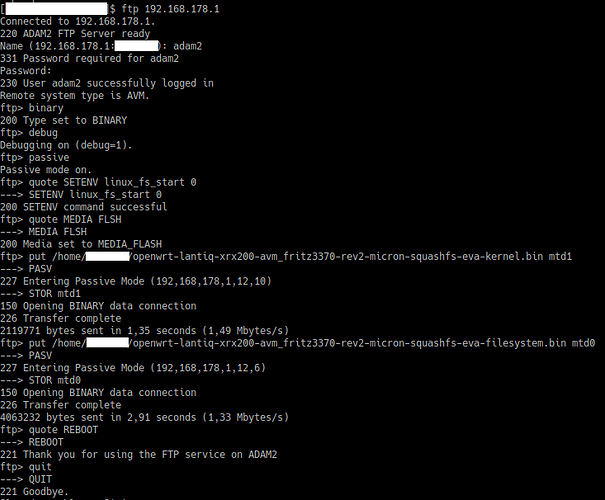I have already setted that. The question is still in which time window I have to send the ftp command?
I'm pretty sure it's during the time the info LED flashes (because I seem to remember it not stopping flashing once the connection has been successfully made), but forgive me for being fuzzy on that, I haven't done this in a long time. You could also watch your computer's network adapter if and when it indicates an ethernet connection (for example by flashing some LEDs on its connector).
Edit: It should be noted that at some point this has to work, it's the way AVM's official "recovery tool" restores a broken Fritz!Box, too.
Like a joke ...
After I got by chance the right time, everything went well (see screenshot).
When I had logged off by typing quit, the FritzBox is restarted, previously only the red Info-light had flashed.
It is still the old FritzOS available. 192.168.178.1 opens the web interface of the 3370.
What does that mean? 
I'm not entirely sure. From the looks of it, flashing went through well. My guess would be that your browser still has the old FritzBox web page in cache, or if its bootloader is particularly weird, the Fritz!Box still has the old system in memory ("reboot", obviously, didn't do anything, and "quit" might not have rebooted it). Your new OpenWrt system should not even react to 192.168.178.1, by default it should be on 192.168.1.1 -- and not come with a web interface in snapshots anyway.
Have you tried turning it off and on again?  This time with your computer set to DHCP?
This time with your computer set to DHCP?
I had the device disconnected from the power for 20 minutes, reconnected. The old system is still active. Is write protection possibly active, or did I describe the wrong partitions?
That doesn't make any sense.
Mybe I'm in the wrong interface, because there was no option to
ftp> quote USER adam2
ftp> quote PASS adam2
I should directly enter the username.
So, being a good obstetrician, I read up a bit for you. Turns out, a Fritz!Box can carry two separate systems, and they can be toggled using
quote SETENV linux_fs_start x
where x is either 0 or 1. If you flashed OpenWrt like above, this should be set to 0.
By issuing
quote GETENV linux_fs_start
you can see which system is "active" at the moment and will be started.
Speculation: I could imagine that the box switches to 1 on its own if it doesn't manage to boot from 0. Which might indicate that something went wrong with flashing the two images (although I don't see that anything went wrong), or that you chose the wrong image ("micron" instead of "hynix"). Did you check which flash chip you have in your box? Did you check your hardware revision?
Also the "quote" prefix is to issue commands that are not directly related to FTP (like the "put" command) but should be passed through to the bootloader itself. Directly entering username and password without "quote" is normal if the ftp client recognizes the request for it. But since all of your commands, especially quote MEDIA FLSH, are acknowledged and executed, you are definitely in the right place.
First of all, thank you for dealing with this topic for me! 
That the box automatically switches to the other system due to an error, I think synonymous for the most plausible, otherwise it was something in the OpenWrt Wiki.
Which Flashchip my 3370 used, I extra twice (once by opening and reading, once by reading the logs) verified, it was the Micron chip in HWRev. 5.
Maybe I should open a new topic for that problem.
offtopic:
It would be fantastic if AVM, similar to how it makes DELL with its Developer Edition (Ubuntu preinstalled), FRITZ!Box with either FritzOS, or optionally with OpenWRT would offer.
I'm pretty sure the "dual image" system is in place to prevent bad firmware updates. An update will go to the respective non-active image, and then switched over. If, for whatever reason, the newly flashed firmware fails to boot it would automatically switch back to the previously installed known working one. Which is probably what happened to you. I just can't see anything you did wrong.
If you do have serial (you mentioned above you "hit a key"?), you could actually watch your bootup process and see if and why it wouldn't boot.
I mean completely instead of FritzOS.
There are a Power and a WLan Key, I assumed they had been meant that way. ![]()
To avoid confusion, I opend a new topic for my problem here:
Now, OpenWrt is running. 
I have two more questions:
- I couldn't find a menu to logging in later with the DSL access data of my provider
- Where can I find the configuration of the hardware-buttons, do I need the package
wifitoggleand another one for the power-button?
I'm not sure what you mean by that. A DSL connection is set up as WAN in /etc/config/network, or if you get LuCI to run, in Network->Interfaces->WAN (edit). There are tutorials to set up PPPoE for OpenWrt, a few smaller details depend on your ISP.
OpenWrt does not have a fixed, or user-friendly, concept of buttons. Basically what it does is execute a shell script when a button is pressed. wifitoggle is an add-on package that hooks into that concept, and it might help you, yes. As for the power button ... that thing physically cuts power to the device, there isn't anything you can do with it in software.
Thank you. 
This topic was automatically closed 5 days after the last reply. New replies are no longer allowed.
